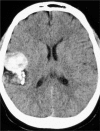Secondary spontaneous thrombosis of a giant aneurysm located distally on a feeding artery after embolization of an associated arteriovenous malformation
- PMID: 20591316
- PMCID: PMC3547378
- DOI: 10.1177/159101990300900406
Secondary spontaneous thrombosis of a giant aneurysm located distally on a feeding artery after embolization of an associated arteriovenous malformation
Abstract
Giant aneurysm located in the distal part of the feeding artery associated with a cerebral arteriovenous malformation is rare and the treatment is clinically challenging. We report the spontaneous and complete thrombosis of a flow-related giant aneurysm immediate up-stream to a cerebral arteriovenous malformation by embolization of that malformation alone in a patient presenting with complex partial seizure and no history of intracranial haemorrhage. We obviated the need to directly intervene on the giant aneurysm, thus reducing unnecessary procedure related risks to the patient. Follow up one year later confirms the thrombosis and show shrinkage of the mass. The patient is asymptomatic.
Figures





References
-
- Anderson RM, Blacwood W. The association of arteriovenous angioma and saccular aneurysm of the arteries of the brain. J Pathol Bacteriol. 1959;77:101–110. - PubMed
-
- Batjer H, Suss RA, Samson D. Intracranial arteriovenous malformations associated with aneurysms. Neurosurgery. 1986;18:29–35. - PubMed
-
- Arai H, Sugiyama Y, et al. Multiple intracranial aneurysms and vascular malformations in an infant. Case report. J Neurosurg. 1972;37:357–360. - PubMed
-
- Aarabi B, Chambers J. Giant thrombosed aneurysm associated with an arteriovenous malformation. Case report. J Neurosurg. 1978;49:278–282. - PubMed
LinkOut - more resources
Full Text Sources

